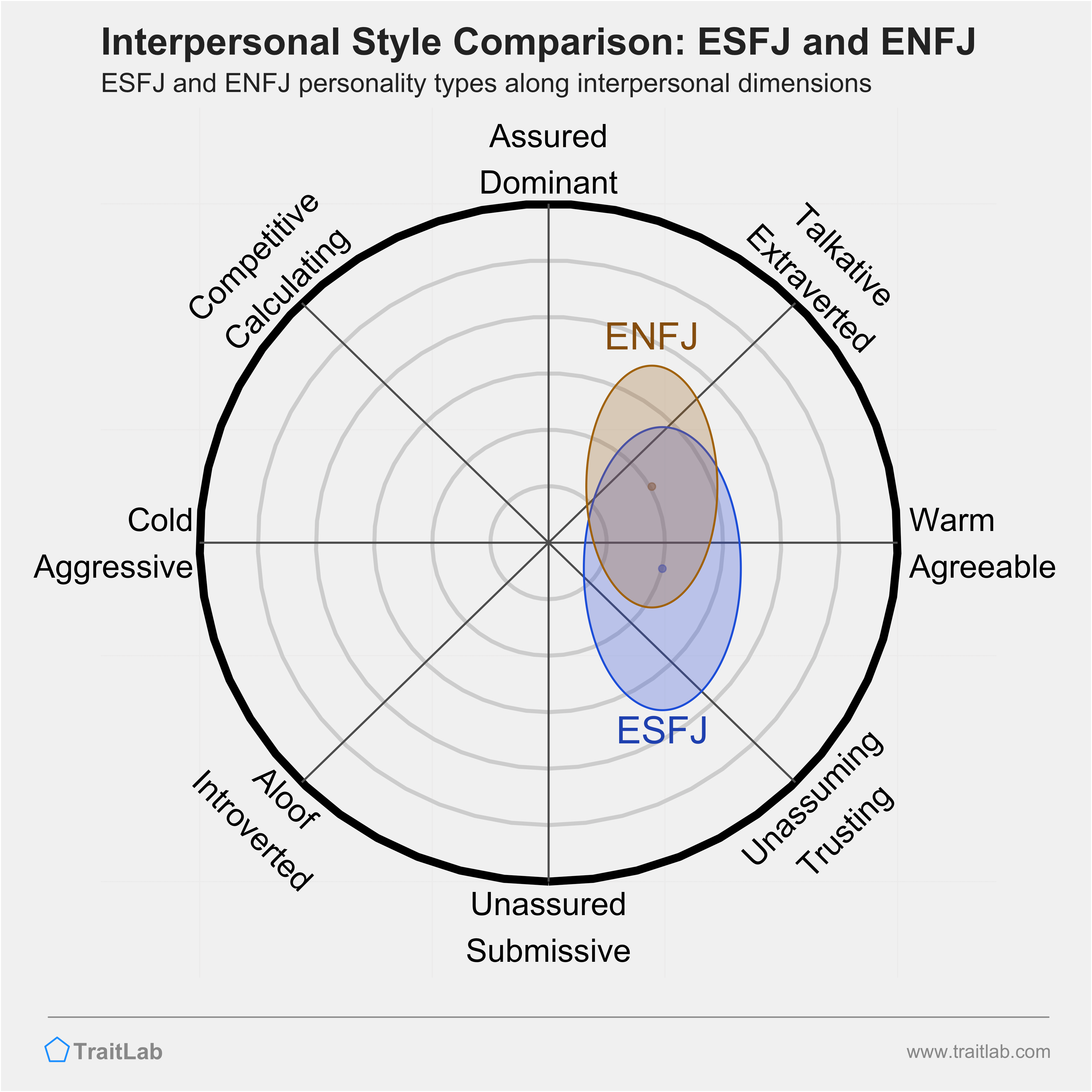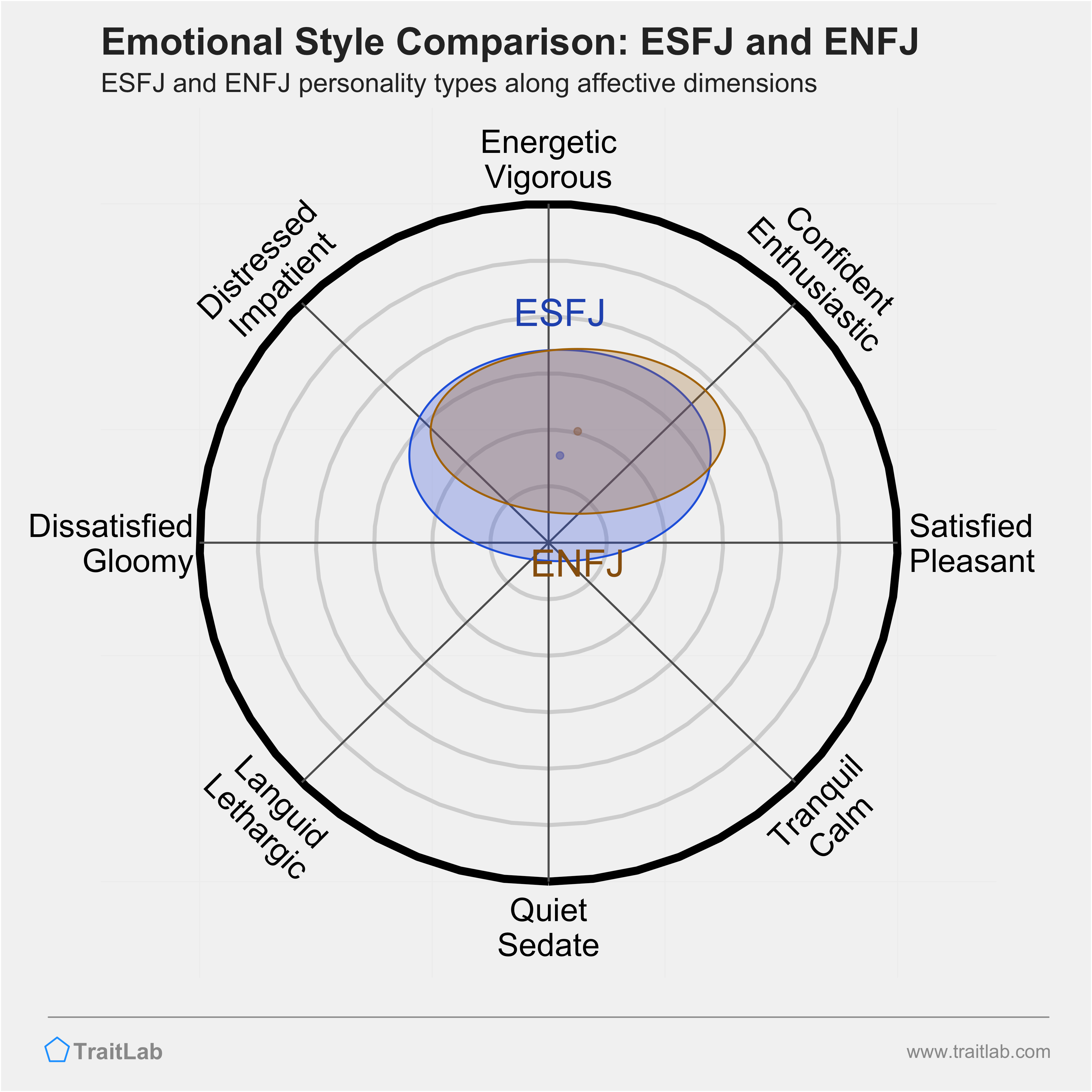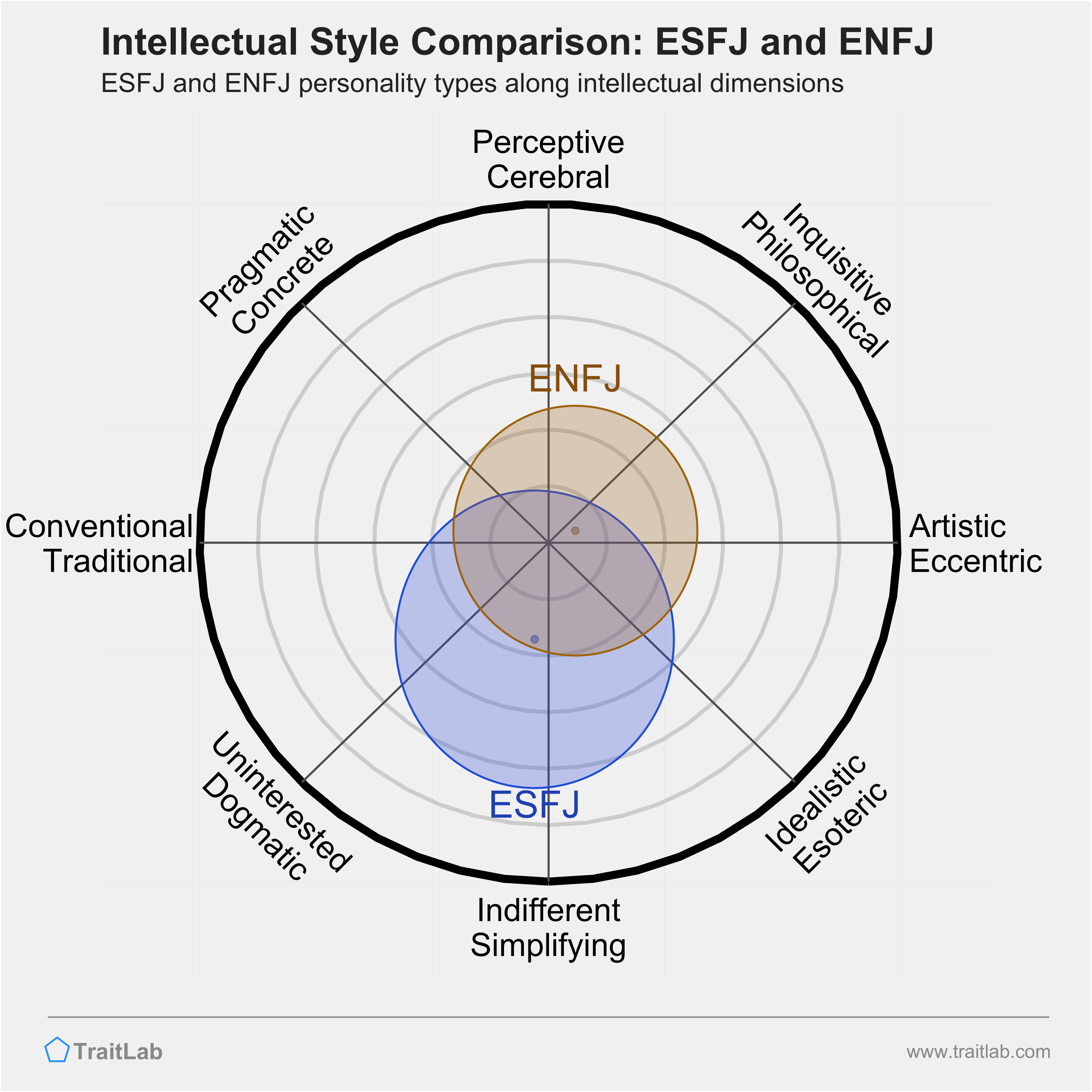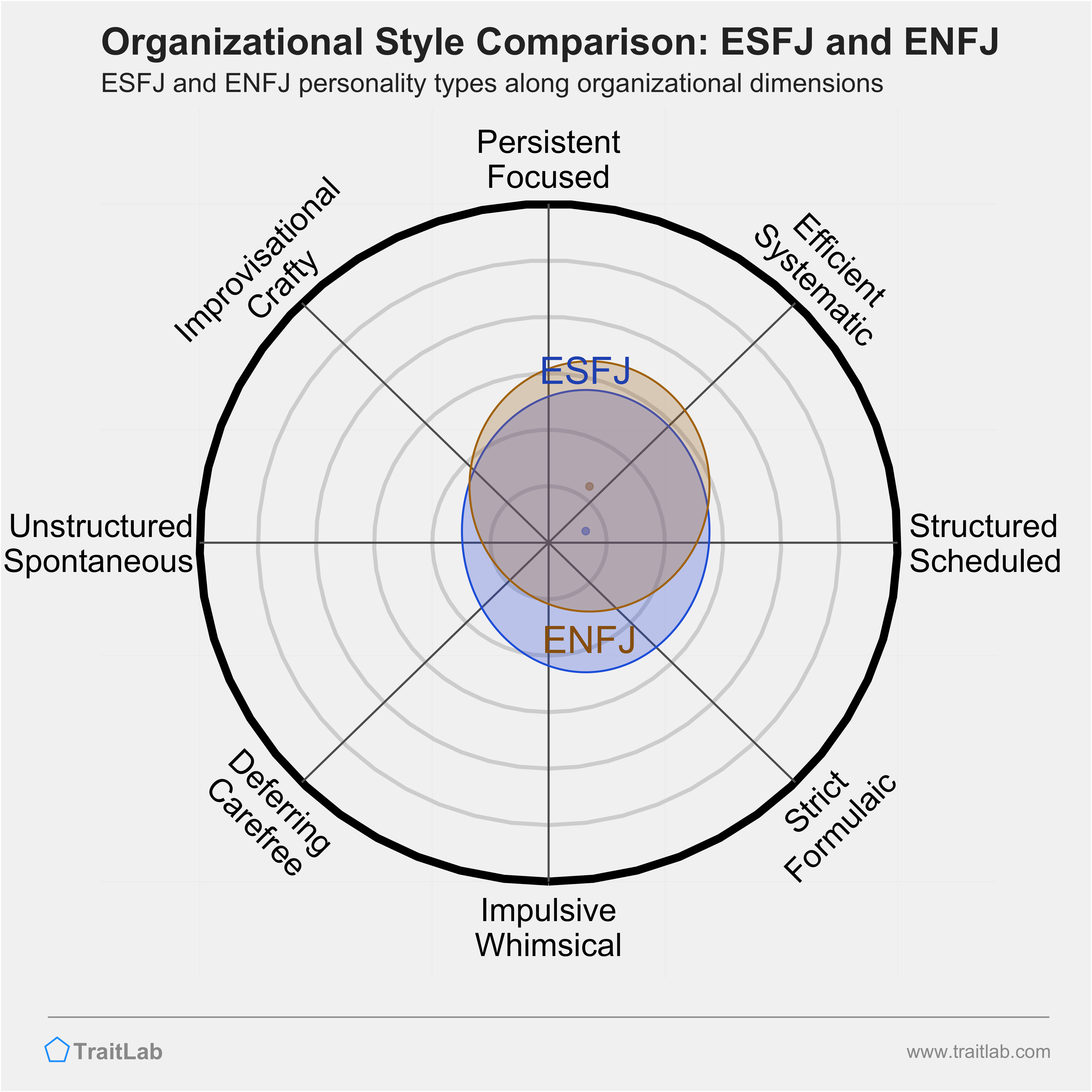How compatible are ESFJ and ENFJ patterns of communicating, thinking, and working?
Reading time: 5 minutes

Gregory Park, Ph.D.
Author
In this article, you’ll find a comparison of ESFJs and ENFJs across five important personality domains: Interpersonal/Communication Style, Emotional Style, Intellectual Style, and Organizational Style.
One important note: the following comparisons cannot be made simply by comparing the cognitive functions (letters) of each personality type.
For this analysis, TraitLab gathered data about personality traits from thousands of participants who identified themselves as a particular type in the 16 Personality or Myers-Briggs framework.
The comparisons here show the average similarities and differences between ESFJs and ENFJs. However, remember that all personality types are oversimplifications. For an assessment of your unique position in these areas, you’ll need a personalized assessment that doesn’t rely on personality types.
Jump to any section with the links below.

Do you know your personality type?
Learn about your type and so much more with TraitLab's comprehensive personality assessment.
Your particular style of communicating and interacting with others can be described fairly well by two dimensions: assertiveness and warmth.
Assertiveness describes your tendency to assert yourself, lead, and influence others in social situations, while warmth describes your tendencies to empathize and put others’ needs ahead of your own.
People with the same personality type often share some similarities in assertiveness and warmth. In the graph below, you can see where most ESFJs and most ENFJs fall along both of these dimensions.
First, take a look at where people in each type, on average, fall in this interpersonal space.

ESFJs often agree, trust, and cooperate with others. At their best, they are friendly, affectionate, and bring out the warmth and sympathy in others. ESFJs may be too agreeable and quick to compromise. At their worst, they may seek approval and agreement too much, and be dependent on the approval of other people.
ENFJs often support, openly sympathize, and actively offer help to others At their best, they are gentle sympathizers, who are easily trusted and accepted. ENFJs may be overly revealing and have difficulty being alone. At their worst, they can require too much attention and admiration from others and be excessively involved in the affairs of others.
One aspect that you and many ENFJs have in common in their interpersonal warmth. Both ESFJs and ENFJs tend to be on the friendlier side and are attentive to the needs and interests of other people, sometimes at the expense of your own goals.
One important difference between you and most ENFJs is in your relative assertiveness or passivity in social situations. Like many ESFJs, you are often on the more passive, reserved side of the spectrum. In some cases, this is a perfect compliment to ENFJs’ more dominant, assertive style, and the two of you can make an effective team. However, you may find that you need to put extra effort into making your opinions heard when working with ENFJs.
Another characteristic of your personality is your emotional style — your tendencies towards different kinds of moods. There are two dimensions that influence emotional style: arousal and valence.
Arousal describes your relative energy level across different situations. Those with high baseline levels of arousal tend to be generally more alert, active, and engaged, while those with a lower baseline are more reserved, subdued, and inhibited.
Valence describes whether these moods tend to be positive (pleasant) or negative (unpleasant). People with a more positively valenced style are more likely to experience emotions like joy, enthusiasm, satisfaction, and serenity. People with a more negatively valenced style are more likely to experience sadness, frustration, dissatisfaction, and anxiety.
The graph below shows where each type, on average, usually sits in this emotional space.

Most ESFJs and ENFJs overlap heavily in their emotional style.
ESFJs and ENFJs tend to be energetic and enthusiastic across most situations. They take on new challenges with excitement, confidence, and a sense of adventure. ESFJs and ENFJs are usually more optimistic than most people, and they generally feel like they can handle what life throws at them.
Like most ESFJs, you and many ENFJs share a relatively high energy level. You both prefer to be in motion, actively engaged in something interesting, rather than sitting back and observing. In the best case, the two of you feed off the other’s energy and excitement, and there’s rarely a quiet moment when you’re together.
Likewise, both ESFJs and ENFJs are generally more positive than negative. They are more likely to express enthusiasm, satisfaction, happiness, and other positive emotions across most situations. Like everyone else, they occasionally experience negative emotions like sadness, anxiety, and anger, but they soon return to their usual pleasant state. Together, ESFJs and ENFJs tend to share an optimistic outlook and a resilience to stress.
Your intellectual style describes how you receive, process, and pursue different kinds of information. Differences in intellectual style are captured well by two dimensions: ideas and aesthetics.
Ideas describes your appetite for new information and your interest in complex, challenging material. People high on the ideas dimension have an appreciation for complexity and technical details. People lower on ideas are less interested in learning for learning’s sake, and they prefer to simplify complex topics down to the essential details.
Aesthetics captures your relative interest and sensitivity to aesthetic information and its emotional impact. People higher on the aesthetics dimension usually have strong artistic interests and a deep appreciation for beauty in many forms. Those lower on aesthetics tend to value practical application over artistic merit and usually adhere to more conventional standards of beauty.
In the graph below, you’ll see where ESFJs and ENFJs, on average, fall in this intellectual space.

ESFJs are practical realists. They focus on building practical skills and essential knowledge and are less likely to spend time learning for learning’s sake. In addition, they usually value conventional, tangible accomplishments over artistic expression and rarely feel compelled to develop a creative outlet.
ENFJs tend to be deep thinkers — bright, curious, and philosophical. They are highly receptive to new ideas and drawn to complex, abstract concepts. ENFJs enjoy taking in large amounts of information and typically have one or more creative outlets.
Like most ESFJs, you are less interested in learning purely for learning’s sake, compared to most ENFJs. You’d prefer to focus on the essentials and the practical issues at hand, while your ENFJ counterpart typically wants to dig deeper and understand the bigger picture. In conversations, you may find that your ENFJ partner often gets caught up in theoretical or abstract details, and you need to bring them back down to earth.
Another difference between ESFJs and ENFJs is their relative interest in aesthetic, artistic, and emotional experiences. As a ESFJ, you tend to be more practical and focused on tangible results, while your ENFJ counterpart is more likely to be drawn into the emotional and artistic aspects of an experience. In addition, ESFJs and ENFJs often differ in their receptivity to unconventional and eccentric ways of thinking. Like many ESFJs, you often lean towards well-worn, conventional approaches and view new alternatives with healthy skepticism. In contrast, ENFJs are quicker to do away with convention and embrace a new approach.
Your organizational style describes your habits around organization and planning. Your organizational style influences how you structure your time and physical space. Differences in organizational style fall along two dimensions: industriousness and orderliness.
Industriousness describes your persistence, need for achievement, and intensity of focus. People higher on industriousness usually organize their behavior around a few important long-term goals. People lower on industriousness are usually more focused on the present and will more easily change their focus when new opportunities appear.
Orderliness describes your need for regularity, order, and structure in your environment. People higher on orderliness prefer tidy, organized physical spaces, detailed schedules, and reliable routines. People lower on orderliness can tolerate more disorganization and prefer a more spontaneous, unstructured approach.
The graph below shows the average position of ESFJs and ENFJs along these dimensions of organizational style.

Most ESFJs and ENFJs share a similar organizational style.
ESFJs and ENFJs are usually systematic and highly organized. They like setting big, long-term goals and then creating detailed plans to accomplish them. ESFJs and ENFJs are generally good at ignoring distractions and making steady progress through consistent routines and habits.
As an ESFJ, you and most ENFJs share a natural drive to achieve and perform at a high level. Both of you enjoy setting goals and pushing yourselves to accomplish them, and you likely share an interest in self-improvement and productivity strategies. As a result, you and your ENFJ counterpart can fuel each other’s ambition and keep each other accountable as you work towards your long-term goals. However, between the two of you, nobody usually reminds you to slow down and enjoy the present.
Similarly, ESFJs and ENFJs tend to be neat, tidy, and organized. You both rely on high amounts of structure and routine and compared to most people, you have lower tolerances for messiness and disorder. With a few exceptions, both of you stick closely to most social conventions and feel uncomfortable straying from them.
Most people have complex personalities and don’t fall into a single personality type.
With TraitLab’s comprehensive analyses of your traits, strengths, and interests, you can see how your personality compares to all 16 types. Start building your personality profile by creating a free account today.
For comparisons between ESFJs and other types from the 16 Personality typology, visit any of the type pairings below:
For comparisons between ESFJs and other Enneagram types, visit any of the type pairings below: